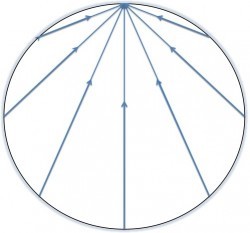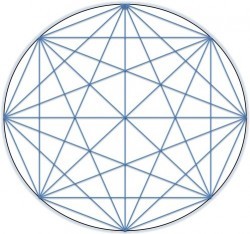I was observing a four-hour team meeting of the company's president and his eight direct reports. Sitting around a table, one at a time each person reported what was happening in his or her area. The president asked questions. The others listened until it was their turn. There was no real discussion.
I sometimes map the energy flow by drawing an arrow each time someone speaks to another person. The energy flow at this meeting looked like this, with the president being the focal point of the meeting.

What was the purpose of the meeting? Although it was not articulated, it was clear that the purpose was to share information with the president in the most time efficient manner —for the president.
Besides being a waste of everyone else's time, a huge opportunity was lost. The senior leadership of this company had gathered together and had not taken advantage of the opportunity for the team to provide leadership for the company as a whole.
Holding a meeting to keep people informed is not a good reason to meet. There are a lot of effective alternatives for sharing information.
If the energy flow in your meeting looks like the above diagram for an extended period of time, most likely your meetings are not necessary.
The only good reason for a team to meet is to create and tap into the collective wisdom.
The map of energy flow, over time, should look closer to this:

Three steps to determine whether a meeting is necessary.
1. Identify the meeting purpose – why you need to meet. If the purpose doesn't include one of these reasons, don't call a meeting.
- To make joint decisions using everyone's best thinking
- To work together on things you cannot accomplish as well working separately
- To utilize each other's expertise
- To create a common perspective – everyone hears the same thing at the same time, answer questions and create shared meaning
- To create a big picture view beyond each person's individual area of responsibility
- To create and maintain alignment – ensure a shared vision (purpose, values and destination)
- To strengthen relationships and increase trust
2. List your desired outcomes for the meeting. Answer: "At the end of the meeting, what will have been accomplished?"
3. Build your agenda after you identify the purpose and desired outcomes. Make sure that each agenda item supports the purpose and drives one of your desired outcomes. If it doesn't, take it off the agenda.
If you do host a meeting, don't keep people in the dark. Provide a copy of the agenda with the purpose and desired outcomes at the top. It will help everyone stay focused, even if this is a regular meeting with a standing agenda.
Better yet, determine the purpose, desired outcomes and build the agenda with your team. That's a worthwhile use of everyone's time.
Thanks to Jesse Lyn Stoner / Sea Point Center / Jesse Stoner
http://seapointcenter.com/no-more-boring-meetings/
| To Get Uninterrupted Daily Article(s) / Review(s) Updates; Kindly Subscribe To This BlogSpot:- http://ZiaullahKhan.Blogspot.com/ Via "RSS Feed" Or " Email Subscription" Or "Knowledge Center Yahoo Group". | ||
| Amazon Magazine Subscriptions | Amazon Books | Amazon Kindle Store |
| Amazon Everyday Low Prices, Sales, Deals, Bargains, Discounts, Best-Sellers, Gifts, Household Consumer Products | ||
No comments:
Post a Comment